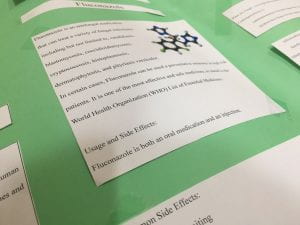In Ladakh, we’ve recently been working in small groups in order to produce three separate videos that can combine to form one video that displays the different goals and plans of Ladakh GC, along with how they connect to the goals and plans of the group that Ladakh GC works with.
My group was set to answer the following questions:
- What are the goals for Ladakh GC this year?
- How do the goals of both Ladakh GC and the Lamdon and Thiksey schools overlap with the UN SDGS?
- What does the Lamdon school do for its students in terms of education?
This involved some research from all the different members, and I directed the younger members to focus on the first question, while myself and another 11th grader each took question 2 and 3 respectively. From this, we then wrote an audio script that would be recorded separately from the visuals.
The Audio Script:
In Ladakh GC, we aim to cover multiple aspects of service in order to best support out NGO. Our indirect goal for Ladakh GC is to raise money for improving infrastructure, specifically improving sanitary conditions, while our direct goal is to raise funds, $1000, to purchase musical and sports equipment and send a project week group to Ladakh.
Part of the UWCSEA core values is to have a strong connection to the world around us, and to have personal engagement in global issues. As a result, all Global Concern service groups are connected to at least one of the United Nations Sustainable Development Goals, along with the personal goals of the NGO or organisation.
The UWCSEA Ladakh GC aims to promote Ladakhi culture whilst aiding the efforts of Lamdon school; this will be by providing necessary classroom materials and organizing 1 key event that we will raise majority of our funds by.
The schools that we work with, the Lamdon and Thiksey schools, have a specific mission that Ladakh GC supports through shared beliefs. The schools have an extensive list of their missions and visions, as can be seen below.
Vision and Mission of Lamdon School:
- To eradicate evils from society by lighting the lamp of education, thus to have a fully content, happy and healthy society
- To achieve our aims and objective
- To provide quality education and equality to all
- To preserve and promote the rich cultural heritage of Ladakh
- To teach the Ladakhi language as a compulsory subject
- To install good values in the minds of the children
- To inculcate a sense of a responsible citizen
- To teach the basics of Buddhism from the start
- To provide free education to the children from poor families (by promotion of sponsorship)
- To provide an education grounded in our own culture to lead a happy and prosperous life
Overall, the mission of the schools are to improve society by giving children of all backgrounds the opportunity to receive a quality education that encompasses the cultural heritage of Ladakh, the sense of good values, and the understanding and participation of Buddhism.
From this, it is possible to connect the goals of Ladakh GC and the Lamdon school to the United Nations Sustainable Development Goals number four and number ten, which are quality education and reduced inequalities, respectively. These goals align closely with target 4.7 of quality education that: By 2030, all learners can acquire the knowledge and skills needed to promote sustainable development, including, among others, through education for sustainable development and sustainable lifestyles, human rights, gender equality, promotion of a culture of peace and non-violence, global citizenship and appreciation of cultural diversity and of culture’s contribution to sustainable development.
The goals of Lamdon and Thiskey overlap with the goals of the UNSDGS in terms of giving quality education to those that can’t afford it, reduce inequality and bring about a change for a better world.
The Lamdon School in Leh has 2175 students and nine other branches all over Ladakh including in the most remote areas. Eight hundred of these students are sponsored by various different donors. The Lamdon School is especially devoted to helping children from remote areas and poor backgrounds and charges a very nominal fee from those students who do not have sponsors. It focuses on preserving their culture and to which end it has made Tibetan Language compulsory till class 8. Those students interested in pursuing their traditional language have the option of continuing with it till class 12. The school has two residential hostels – one for the boys and the other one for the girls. This is an essential aspect of a school devoted to making education accessible for children from remote areas. A hostel acts as a home away from home for these children and they become a family of sorts as their families are mostly very far away. It is critical to the development of a child to have a safe sanctuary to grow up in.






 with their family and bring some food and blankets to sing along with some Christmas carols for the evening. Earlier that week, Ms Stirrat asked a few of us in Sonos if we were free to help sing some songs on the Friday. Along with Georgia, Emily, Lydia, and Hannah from Bersama, we met on Wednesday to choose some Christmas carols that we wanted to perform. We settled on White Winter Hymnal, Silent Night, White Christmas, Hark the Angels, We Three Kings, and It’s Beginning to Look a Lot Like Christmas. We spent around an hour and a half learning the different songs and testing some different ideas out. We decided to combine some of the songs and shorten certain parts, and tested the way our voices sounded with others, eventually coming up with partners in the song to sing different parts.
with their family and bring some food and blankets to sing along with some Christmas carols for the evening. Earlier that week, Ms Stirrat asked a few of us in Sonos if we were free to help sing some songs on the Friday. Along with Georgia, Emily, Lydia, and Hannah from Bersama, we met on Wednesday to choose some Christmas carols that we wanted to perform. We settled on White Winter Hymnal, Silent Night, White Christmas, Hark the Angels, We Three Kings, and It’s Beginning to Look a Lot Like Christmas. We spent around an hour and a half learning the different songs and testing some different ideas out. We decided to combine some of the songs and shorten certain parts, and tested the way our voices sounded with others, eventually coming up with partners in the song to sing different parts.
